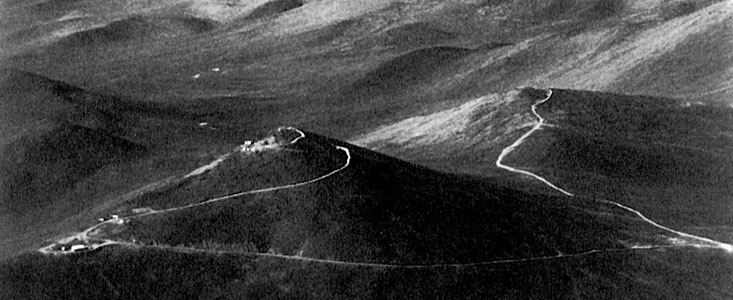Persbericht
The Best Site for the Biggest Telescope: The VLT Goes to Paranal
4 december 1990
The Council of the European Southern Observatory, in session today at the ESO Headquarters in Garching near Munich, unanimously decided that the world's largest optical telescope, the 16-metre equivalent Very Large Telescope, shall be placed on Cerro Paranal [1], an isolated mountain top at 2664 m altitude in the central part of Chile's Atacama desert, some 130 kilometres south of the town of Antofagasta and 12 kilometres from the Pacific coast.
This decision by the delegates from ESO's eight member states is based on the most extensive, comparative meteorological investigation that has ever been carried out in connection with the selection of an observatory site. For more than six years, continuous, accurate measurements have shown that Paranal is the best continental site known in the world for optical astronomical observations, both in terms of number of clear nights and stability of the atmosphere above.
In anticipation of the choice of Cerro Paranal as the future site of the VLT Observatory, the Chilean Government has donated a 725 km2 area around Paranal to ESO in order to ensure the continued protection of the site against all adverse influences, in particular light pollution and mining activities.
The advantages of Paranal
The meteorological and climatological investigation incorporated a detailed comparison between Paranal and the present site of ESO's telescopes, La Silla, by means of identical measuring equipment. Despite La Silla's world-wide reputation for excellent observing conditions, Paranal was found to be even better, mainly because of its location in a more stable and drier climate in the most arid part of the Atacama desert.
Interestingly, in terms of atmospheric stability La Silla was found to be better than previously thought, with a measured median "seeing" [2] of 0.76 arcsec. Paranal is better with a mean of 0.66 arcseconds, but of even greater importance is the fact that the number of clear nights of exceptional quality (seeing better than 0.5 arcsecond) is about 2.4 times higher on Paranal (16% of all nights) than on La Silla (7 %). Indeed, during one night in September 1990, the mean seeing at Paranal (over 10 hours) was measured with a "seeing monitor" as only 0.32 arcsecond, reaching the incredibly good value of 0.25 arcseconds during three consecutive hours.
The atmospheric conditions on Paranal will allow the VLT to take full advantage of its unique imaging and spectroscopic capabilities so that fainter and more distant objects can be observed than with any other telescope in the world. Moreover, when the VLT is supported by "adaptive optics", it will produce images that are almost as sharp as if it were in space. In the "interferometric" mode, when the light from the four 8.2-m telescopes is combined coherently (in the same phase), the resolving power of the VLT is further increased, so that even finer details can be seen. Under optimal circumstances, it should be possible to achieve a resolution of 0.0005 arcseconds. This would correspond to imaging 1 metre objects on the surface of the Moon.
Because of the extremely low atmospheric water vapour content in the Paranal region, probably the driest area on the surface of the Earth, this site is also highly suited for astronomical observations in the infrared and submillimetre wavelength regions.
Organizational issues
The decision to place the VLT Observatory at Paranal implies that some years from now ESO will operate two geographically separate observatories in Chile. In order to ensure the optimal functioning of both units, it will be necessary to adjust ESO's set-up in Chile.
The efficient running of the La Silla Observatory, on which so many European astronomers are dependent, will of course continue to have high priority, but it is expected that a certain streamlining will have to be made of the operations there. The ESO management is now looking into how this can best be done and will, in agreement with the ESO Council, implement the necessary changes over the coming years.
Next steps
ESO is proceeding with the detailed planning of the VLT Observatory. The next step will be to decide about the exact configuration of the four 8.2-metre telescopes and their enclosures. Several major contracts will be signed with European industry during the coming year, for instance for the construction of the mechanical structure of the giant telescopes and also the buildings which will be erected on Paranal. The first of the 8.2-m telescopes will be ready on Paranal in 1995.
Noten
[1] This Press Release is accompanied by a geographical map showing the location of Paranal, and an aerial view of the mountain.
[2] Astronomical "seeing'' is a measure of the sharpness of stellar images as seen in a telescope, introduced by the turbulence in the atmosphere above; the smaller it is, the sharper are the images. With sharper images, more details can be seen in celestial objects and the fainter and more remote are the objects that can be seen at all. A typical seeing in Europe is 2 - 3 arcseonds. For observations in the infrared region of the spectrum, the adverse effects of the seeing can be overcome by "adaptive optics", cf. eso9006 of 23 May 1990
Contact
Richard West
ESO
Garching, Germany
Tel: +49 89 3200 6276
E-mail: information@eso.org
Over dit bericht
| Persberichten nr.: | eso9015 |
| Legacy ID: | PR 11/90 |
| Naam: | Cerro Paranal, Very Large Telescope |
| Type: | Unspecified : Technology : Observatory |
| Facility: | Very Large Telescope |
Our use of Cookies
We use cookies that are essential for accessing our websites and using our services. We also use cookies to analyse, measure and improve our websites’ performance, to enable content sharing via social media and to display media content hosted on third-party platforms.
ESO Cookies Policy
The European Organisation for Astronomical Research in the Southern Hemisphere (ESO) is the pre-eminent intergovernmental science and technology organisation in astronomy. It carries out an ambitious programme focused on the design, construction and operation of powerful ground-based observing facilities for astronomy.
This Cookies Policy is intended to provide clarity by outlining the cookies used on the ESO public websites, their functions, the options you have for controlling them, and the ways you can contact us for additional details.
What are cookies?
Cookies are small pieces of data stored on your device by websites you visit. They serve various purposes, such as remembering login credentials and preferences and enhance your browsing experience.
Categories of cookies we use
Essential cookies (always active): These cookies are strictly necessary for the proper functioning of our website. Without these cookies, the website cannot operate correctly, and certain services, such as logging in or accessing secure areas, may not be available; because they are essential for the website’s operation, they cannot be disabled.
Functional Cookies: These cookies enhance your browsing experience by enabling additional features and personalization, such as remembering your preferences and settings. While not strictly necessary for the website to function, they improve usability and convenience; these cookies are only placed if you provide your consent.
Analytics cookies: These cookies collect information about how visitors interact with our website, such as which pages are visited most often and how users navigate the site. This data helps us improve website performance, optimize content, and enhance the user experience; these cookies are only placed if you provide your consent. We use the following analytics cookies.
Matomo Cookies:
This website uses Matomo (formerly Piwik), an open source software which enables the statistical analysis of website visits. Matomo uses cookies (text files) which are saved on your computer and which allow us to analyze how you use our website. The website user information generated by the cookies will only be saved on the servers of our IT Department. We use this information to analyze www.eso.org visits and to prepare reports on website activities. These data will not be disclosed to third parties.
On behalf of ESO, Matomo will use this information for the purpose of evaluating your use of the website, compiling reports on website activity and providing other services relating to website activity and internet usage.
Matomo cookies settings:
Additional Third-party cookies on ESO websites: some of our pages display content from external providers, e.g. YouTube.
Such third-party services are outside of ESO control and may, at any time, change their terms of service, use of cookies, etc.
YouTube: Some videos on the ESO website are embedded from ESO’s official YouTube channel. We have enabled YouTube’s privacy-enhanced mode, meaning that no cookies are set unless the user actively clicks on the video to play it. Additionally, in this mode, YouTube does not store any personally identifiable cookie data for embedded video playbacks. For more details, please refer to YouTube’s embedding videos information page.
Cookies can also be classified based on the following elements.
Regarding the domain, there are:
- First-party cookies, set by the website you are currently visiting. They are stored by the same domain that you are browsing and are used to enhance your experience on that site;
- Third-party cookies, set by a domain other than the one you are currently visiting.
As for their duration, cookies can be:
- Browser-session cookies, which are deleted when the user closes the browser;
- Stored cookies, which stay on the user's device for a predetermined period of time.
How to manage cookies
Cookie settings: You can modify your cookie choices for the ESO webpages at any time by clicking on the link Cookie settings at the bottom of any page.
In your browser: If you wish to delete cookies or instruct your browser to delete or block cookies by default, please visit the help pages of your browser:
Please be aware that if you delete or decline cookies, certain functionalities of our website may be not be available and your browsing experience may be affected.
You can set most browsers to prevent any cookies being placed on your device, but you may then have to manually adjust some preferences every time you visit a site/page. And some services and functionalities may not work properly at all (e.g. profile logging-in, shop check out).
Updates to the ESO Cookies Policy
The ESO Cookies Policy may be subject to future updates, which will be made available on this page.
Additional information
For any queries related to cookies, please contact: pdprATesoDOTorg.
As ESO public webpages are managed by our Department of Communication, your questions will be dealt with the support of the said Department.


